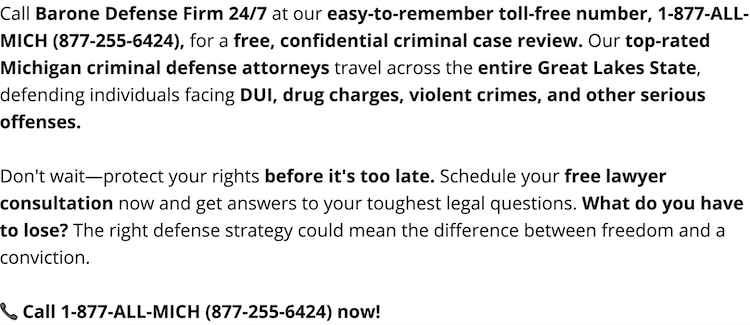How is The Jury Selected?
The most important thing of all in a jury case is that the jurors who decide the case are free of any bias or prejudice that prevent them from being fair and impartial to the accused. Of course, this is easier said than done. Nevertheless, to help move closer to this goal, your federal criminal defense attorney has two tools at their disposal- the jury questionnaire and voir dire.
Most judges in Michigan's Eastern and Western district courts will allow either party to compose a written pretrial questionnaire. Each potential juror is then required to complete this questionnaire before they are brought into the courtroom. The attorneys will have copies of these questionnaires for each potential juror and will have the opportunity to review them prior to the jury panel being brought into the courtroom. The use of such written questionnaires is an indispensable tool in the Federal criminal defense attorney's jury selection toolbox.
Voir dire is a term that means to speak the truth. Voir dire is the live and in-person questioning of each prospective juror. The jurors are placed under oath prior to jury selection. The purpose of putting the prospective jurors under oath is to help the lawyers determine the suitability of each prospective juror for the case being litigated.
A big issue that is becoming more commonly litigated is whether the attorneys themselves will be afforded the opportunity to voir dire the jurors. The rules allow the federal trial court judge to deny the lawyers this opportunity in which case the judge will engage the jurors in voir dire. According to Rule 24 of the Federal Rules of Criminal Procedure, if the court examines the jurors, the judge must allow the lawyers to either ask further appropriate questions or submit such questions in writing.
While the "policy" of whether lawyers or judges get to do the voir dire varies from judge to judge in Michigan's Eastern and Western Districts, the general rule is that judges in the federal system afford defense attorneys considerable latitude in the conducting of wide-ranging voir dire. In cases with complex facts and numerous defendants, just the selection of a jury can take as much as a week or more to complete. However, in those cases where the judge denies the lawyers this opportunity, this can dramatically shorten the voir dire process, and this is often the incentive for this decision. Still, when compared with the state court system, in most cases, voir dire in the federal criminal system is much more extensive.
There are many different ideas and methods that can be utilized for voir dire. Good voir dire is one of the most challenging skills for a defense attorney to master. Because many defense attorneys, including the federal criminal law defense attorneys at the Barone Defense Firm, consider voir dire to be the most important part of the trial, it is an essential skill to develop and master.
How is the Jury Actually Selected?The jury selection will begin with some number of potential jurors being selected. These jurors are often seated inside the jury box. After these perspective jurors have been voir dired, both the AUSA and your federal criminal defense attorney will be asked by the judge if they have any challenges "for cause." A lawyer may ask the judge to "thank and excuse" one or more jurors for cause. Before the court will do so, the federal district court judge must agree that the challenged juror has, in their jury questionnaire or answer(s) to voir dire questions, expressed an "opinion or conscientious scruple" that would prevent them from being fair and impartial on your case. If the judge agrees then this juror will be excused and replaced with another potential juror. There is no limit to the number of for cause challenges that can be made or granted.
Another type of challenge is called a peremptory challenge. With a peremptory challenge, an attorney in a federal criminal case can ask for a particular juror to be excused but does not need to state a reason. However, there is a limit to the number of peremptory challenges that a party may exercise. Rule 24 of the Federal Rules of Criminal Procedure says that each side has 20 peremptory challenges in a capital case where the government seeks the death penalty. For all other felony criminal trials in the federal district courts, the AUSA will have 6 peremptory challenges and the defense attorney will have 10 peremptory challenges. The judge can expand the number of peremptory challenges available to both sides.
Alternate Jurors in a Federal Criminal CaseThe number of jurors changes if the judge decides to empanel alternate jurors. This procedure is also included in Rule 24 of the Federal Rules of Criminal Procedure. The judge may empanel up to 6 alternate jurors. These alternates may become jurors if any of the 12 jurors deciding the case become unqualified for any reason. This could happen, for example, in the case of illness or death, or if something happens during the trial that causes either party or the court to learn that they are no longer qualified. These alternate jurors must be qualified in the same way as the original 12 jurors. If the parties agree, one or more of them may remain on the case to be part of the deliberations and verdict. If this happens, the jury must still be unanimous. If, on the other hand, an alternate replaces one of the original 12 after they have begun to deliberate, they must be advised to restart their deliberations from the beginning.
If the court empanels 2 or less alternate jurors, then the parties are entitled to one additional peremptory challenge. If the court empanels between 2 and 4 alternates, then the parties are entitled to an additional 2 peremptory challenges. If the court empanels more than 4 alternate jurors, then the parties are entitled to an additional 3 peremptory challenges. Both the AUSA and the Federal criminal defense lawyer are entitled to the full number of additional challenges, which would be added to their original number. In a case in which the judge designates 6 alternates, the AUSA would then have a total of 12 whereas the federal criminal defense attorney would have 16.
What Procedures Apply to Jury Selection in a Federal Criminal Trial?There are no mandatory rules or procedures as to how the judge empanels jurors at the beginning of the jury selection. Some judges in the federal district courts proceed with the "struck method," whereby voir dire will be conducted on the total number of panelists necessary to complete the case. The total number is based on the number of standard peremptory challenges, plus any additional challenges for alternates. For example, in a non-capital case, the number of jurors to be selected is 12, plus 10peremptory challenges for the defense, 6 for the AUSA, plus an additional 2 for the four alternate jurors. In the ordinary criminal case, this voir dire would be conducted for the first 28 panelists with no alternates, 30 with 2 alternates, etc.
The Court next entertains any challenges for cause raised by either party. Each panelist who is excused for cause will be replaced. Final voir dire is then conducted, and the parties are offered the opportunity to exercise peremptory challenges.
In this case, assuming you have 30 jurors with 12 jurors on the panel and two alternates, you would then be in a position where juror number 15 would be the first panelist to replace any juror that was successfully challenged and removed. Alternates 16 and 17 would then "move up" in the designation, thus creating a situation where some parties will try to get to a particular juror, let us assume panelist in seat #21 and use their challenges to effectuate that end. It is also possible to use a peremptory challenge on an alternate juror. But in most cases, this seems like an ill-advised strategy.
Once the jury is impaneled, they will be asked to raise their right hand and given an oath. This oath is not prescribed in a statute or court rule. It may vary from Federal court to Federal court. Regardless, the oath is usually some semblance indicating that they will "well and truly try" and reach a "just verdict" based only on the evidence.
The jurors, including the alternates, will also be advised while they are jurors, that they may not contact anyone to discuss or ask questions about the evidence, and, that they may have no discussion amongst themselves about the case. Furthermore, the judge will tell the jurors that all communication will be done with the court officer in writing through the court officer to the judge.
<< Back to the main Federal Criminal Law page || Next Page >>
 Barone Defense Firm Home
Barone Defense Firm Home




















